Airflow obstruction, the classic sign of conditions such as chronic obstructive pulmonary disease (COPD) and chronic asthma, is a long-standing and often permanent issue in the vast majority of adults. Gradual progression of untreated or poorly treated airflow limitation over time results in increased symptoms, decreased quality of life, and rising risks of complications. Long-term evidence-based care is needed to decelerate disease progression and aid in daily functioning.
Understanding Airflow Obstruction
Airway obstruction is airway narrowing or occlusion, which prevents air from having a free entrance or exit into or out of the lungs. Inflammation, increased mucus, alteration in the structure of the airway, or spasm of the airway muscles results in airway obstruction. The two most frequent chronic causes are:
- Chronic Obstructive Pulmonary Disease (COPD): Emphysema and chronic bronchitis, diseases caused mostly by long-term exposure to smoke.
- Chronic (Persistent) Asthma: Inflammatory disease with reversible and sometimes irreversible airflow restriction.
The two diseases have similar management principles, although the specifics vary, and in some cases, medicines like the deriphyllin tablet may be prescribed to help improve airflow and ease breathing difficulties.
Aims of Long-Term Management
The central goals when treating chronic airflow limitation are to:
- Relieve acute symptoms (breathlessness, cough, wheeze)
- Prevent exacerbations or flare-ups
- Slow disease progression
- Facilitate physical activity and daily function
- Reduce risk of hospitalization and complications
Key Strategies for Success
1. Smoking Cessation
The absolute best treatment—particularly in COPD—is to quit smoking. Quitting, as well as slowing lung decline, makes all other therapy more effective. Years after the development of smoking, quitting still has a significant benefit at any point during disease.
2. Pharmacological Therapy (Medications)
Medications are still the mainstay for relief of symptoms and prevention of exacerbations
- Inhaled bronchodilators: Usually the initial treatment. They cause relaxation of airway muscles, so it is easier to breathe. They are available as short-acting (relief) or long-acting (maintenance) preparations.
- Short-acting bronchodilators (like salbutamol) give quick relief of acute symptoms (occurring suddenly).
- Long-acting bronchodilators (like tiotropium or salmeterol) are used daily to keep airways open and prevent symptoms during the day.
- Inhaled corticosteroids: In selected cases, particularly those with frequent exacerbations or a dominant inflammatory factor (such as asthma). They limit inflammation of the airways and quiet symptoms.
- Combination inhalers: Bronchodilators and steroids are generally combined for maximum advantage.
- Other oral medications: Theophyllines may be added to therapy, though their usage has dropped because they have low safety margins.
Deriphyllin tablet, a compound of etofylline and theophylline, is occasionally used for chronic maintenance, especially when symptoms are not controllable with inhalers alone. It is a bronchodilator that relaxes airway muscles to allow greater airflow but is best used with a doctor’s guidance because of side effects and medication interactions.
3. Pulmonary Rehabilitation
Pulmonary rehabilitation is an organized regimen of exercise, education, and behavior modification. It has been shown to:
- Increase breathlessness and endurance
- Improve quality of life
- Decrease exacerbations and hospitalization risk
- Supervised regular exercise optimizes lung function and aids in managing the depression or anxiety that accompanies chronic lung disease.
4. Vaccinations
Annual influenza vaccination and routine pneumococcal vaccination are highly recommended in patients with chronic airflow obstruction. Infections are a frequent cause of disease exacerbation and may usually be avoided by immunization.
5. Oxygen Therapy
Long-term oxygen therapy can be indicated in those with very severe disease and chronically low oxygen levels. Appropriately used (usually 15+ hours/day), it improves survival and energy and function daily.
6. Self-Management and Monitoring
- Inhaler technique: If medications are to be effective, proper usage is needed. Regular review and re-education by health professionals avoid repeated mistakes. Special Feature.
- Exacerbation action plan: Prompt detection of warning signs and knowing when and how to escalate treatment (or access medical assistance) is lifesaving.
- Follow-ups: These are routine reviews enabling monitoring of lung function, optimization of treatments, and early management of new symptoms.
7. Lifestyle modifications
- Well-balanced diet: Proper diet preserves strength and resistance. Weight loss should be achieved by obese patients; underweight patients may require supplementations.
- Physical activity: Get active, even to some extent, to avoid “deconditioning,” in which inactivity leads to muscle weakening—muscles used for breathing included.
- Avoiding triggers: Limit exposure to lung irritants such as smoke, indoor pollution, dust, and pungent fumes.
8. Advanced and Surgical Options
- For others with very severe, unresponsive disease, surgical methods may be considered:
- Lung volume reduction surgery or endoscopic minimally invasive therapies: Surgical removal of diseased lung segments may benefit a few patients with emphysema.
- Lung transplantation: Reserve therapy for highly selected patients with end-stage disease.
Management of Exacerbations
Early intervention and recognition of exacerbations (deterioration of symptoms) are essential. Most are caused by infection of the respiratory tract or irritation by exposure to a noxious substance:
- Boost use of rescue inhalers and adhere to a treatment action plan.
- Acute exacerbations can be treated with oral antibiotics and steroids.
- Prompt phone contact with doctors is required; severe symptoms can be managed only in the hospital.
Potential Side Effects of Medications
The majority of aerosol medications have minimal side effects if used correctly, but all medications—deriphyllin tablet not excepted—have the potential to produce side effects (e.g., headache, nausea, palpitations, insomnia). Inform your doctor at any time regarding new or distressing symptoms for evaluation and titration.
Living Well With Chronic Airflow Obstruction
The majority of adults can live active productive lives in the setting of chronic airflow obstruction provided care is consistent and well-tailored to the patient. Maximizing treatment, remaining on prescribed regimens, and forcefully coordinating with providers are the determinants of success.
Disclaimer:
This article is for information purposes only. It is not intended as a substitute for professional medical care, diagnosis, or treatment. Always consult your doctor before beginning, stopping, or altering medication, such as deriphyllin tablet, or significantly changing your airflow obstruction treatment regimen.
